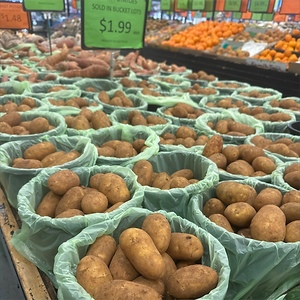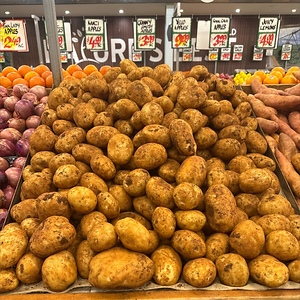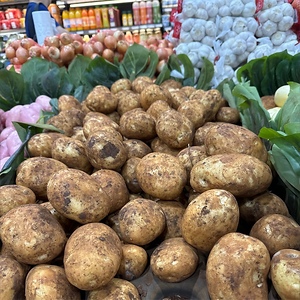


Brushed Potatoes
Estimated Inventory, lb : 0
Description/Taste
Brushed potatoes vary in size and shape, depending on the specific variety and growing conditions. The tubers range in appearance from long, slender, and slightly curved to uniform, broad, oval, or oblong with blunt, curved ends. The skin is typically thin, taut, and smooth to lightly textured, and most varieties sold under the Brushed name have shallow eyes. Brushed potatoes appear brown in markets due to a layer of soil naturally coating the surface. Once the soil is removed, the tuber’s skin varies in shades of tan, light brown, white, cream, and golden hues. Underneath the surface, the flesh is generally white, ivory, or yellow and is firm, dense, and slippery when raw. Once cooked, Brushed potatoes develop fluffy, soft, tender, and creamy textures. Each individual variety will have a slightly different consistency based on their floury or waxy tendencies. Brushed potatoes are edible once cooked and generally have a mix of earthy, nutty, mild, and subtly sweet flavors.
Seasons/Availability
Brushed potatoes are available year-round, with a peak season from May to August in Australia.
Current Facts
Brushed potatoes, botanically classified as Solanum tuberosum, represent a category of commercial tubers sold in Australia belonging to the Solanaceae or nightshade family. Brushed is a descriptor for potatoes sold in commercial markets with a thin layer of soil on the skin. The tubers are brushed instead of washed for market, and this method is said to help extend the potato’s shelf life. The layer of soil coating Brushed potatoes is also thought to help retain moisture within the tuber and act as a natural protective barrier, maintaining overall quality and flavor. Many varieties of potatoes are sold under the general Brushed descriptor in Australia, and most varieties are not labeled by their individual names. Common varieties sold under the Brushed potato moniker include Sebago, Kipfler, and Golden Delight. Some bags of Brushed potatoes may also be comprised of several varieties. Brushed potatoes are generally all-purpose cultivars, allowing them to be used in a wide array of culinary preparations.
Nutritional Value
Brushed potatoes have not been studied for their nutritional properties, as several varieties are sold under this descriptor. Potatoes, in general, are a source of vitamin C, potassium, fiber, vitamin B6, calcium, and iron. Vitamin C strengthens the immune system, helps with collagen production, and aids in iron absorption. Potassium helps to balance and replenish fluid levels within the body and is considered an electrolyte for everyday muscle functions. Fiber regulates the digestive tract, vitamin B6 helps keep nerves healthy, calcium supports bones and teeth, and iron develops the protein hemoglobin for oxygen transport through the bloodstream.
Applications
Brushed potatoes vary in flavor, showcasing mild, earthy, subtly sweet, and nutty nuances. The tubers must be cleaned before use, removing the dirt, and are suited for savory cooked preparations. Brushed potatoes are sometimes sold in bags with mixed varieties. Most Brushed potatoes are all-purpose cultivars, meaning they can be used somewhat universally in potato recipes. In mixed bags, some tubers may be starchier than others, which can be determined by cutting the potato in half. If the tuber sticks to the flat surface of the knife and is challenging to pull off, it is thought to have a higher starch content. Brushed potatoes are popularly steamed or boiled and added to salads. They are also cooked and mashed, boiled and smashed, incorporated into soups, or roasted as a simple side dish. In Australia, Brushed potatoes are viewed as an everyday tuber and are fried into fritters, added to curried dishes, or sliced and layered in casseroles, gratin, bakes, and pies. Brushed potatoes can also be used in bread recipes, made into gnocchi, made into fries, or cooked as a simple side to roasted meats. Brushed potatoes pair well with meats such as beef, poultry, and pork, leeks, spinach, cheeses including gouda, cheddar, blue, and Swiss, and herbs such as rosemary, thyme, chives, and parsley. Whole, unwashed Brushed potatoes will keep for several weeks when stored in a cool, dry, and dark location. It is important to allow the tubers ample air circulation to extend their shelf life.
Ethnic/Cultural Info
Potatoes are one of the top-produced crops within the vegetable sector in Australia. Many different varieties are cultivated across the continent, and each growing region celebrates and promotes the tubers through seasonal events and festivals. In 2024, two notable potato-centric events occurred in Australia. The first International Day of Potato was held on May 30th, 2024, an event developed by the General Assembly of the United Nations. The annual celebration was created to promote potato cultivation and highlight the crop’s nutritional properties, economic importance, and regional significance. Later that year, in June, the World Potato Congress was held in Adelaide, Australia. The World Potato Congress is a non-profit organization that helps industry professionals gather and network to drive potato cultivation, marketing, and sales. The congress is held in a new location each year and has occurred annually since 1993. 2024 was the first time Australia held the gathering and attracted over 1,000 registrations. During the four-day event, the World Potato Congress held networking events, a trade show, speaking engagements, and formal dinners to connect potato breeders, growers, manufacturers, and distributors.
Geography/History
Brushed potato is a marketing term for selling potatoes covered in a layer of soil in Australia. The name encompasses several varieties with varying historical backgrounds. Potatoes, in general, were first planted in Australia in the late 18th century. Some sources note that potatoes were initially planted in Australia by botanist and explorer Sir Joseph Banks, who carried tubers from Brazil around 1770. Later, in 1788, potatoes were carried with passengers from the First Fleet traveling from England to Australia. Potatoes were thought to have been planted in the settlement at Sydney Cove and eventually expanded in cultivation as more settlements were constructed in different locations. Potatoes also reached the island of Tasmania, where they were first commercially grown and shipped to parts of mainland Australia in the 1830s. Over time, potato cultivation spread across Australia, especially into South Australia, and new advancements in irrigation technology in the 1950s and 60s helped broaden cultivation. Since their arrival on the continent, potatoes have been viewed as a staple base ingredient. The tubers are prevalent in markets, and Brushed potatoes are a style of selling potatoes encased in a thin layer of soil. Brushed potatoes fluctuate through periods of popularity and obscurity among commercial markets in Australia. The COVID-19 pandemic contributed to a slight resurgence in Brushed potatoes as consumers sought to purchase locally grown potatoes and viewed Brushed potatoes as more natural and sustainable. Today, Brushed potatoes are cultivated in South Australia, Tasmania, Victoria, New South Wales, Queensland, and Western Australia. The soil-coated tubers are widely found in supermarkets, farmer’s markets, and wholesalers.










